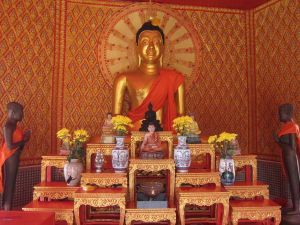Deity, Methods in Tantric Buddhism
The deity in Vajrayana states that the external manifestation of the Ultimate Reality is in the form of deity.
The earlier phase of Buddhism is more or less free of gods and goddesses but during the Tantric phase of Buddhism there has been a deep proliferation of the deities. Buddhism liberally absorbed native gods, based on the perception that every god is a manifestation of the Absolute.
Vajrayanists constructed symbolic figures to experience and express the direct spiritual experience of sunyata. But at the same time Vajrayanistic theism is not without a rider. Advayavajrasamgraha states that the deity springs from the consciousness of sunyata from it the seed-syllable from the bija rises the icon and the icon is the external representation. Advayavajra holds that the deities are nothing but manifestations of sunya and by nature essence-less. The mantra and the deity exist as aspects of the undifferentiated nature. This supreme non-duality is Vajradhra.
Vajryanists went ahead to describe the Ultimate Reality as the Adamantine Being and sometimes as personal God, or the Lord Supreme. The Vajrasattva reconciles in himself the voidness of all natures that is vajra as well as the unity of the three centres which are Body, Speech and Mind.
In the essence the deity is of the nature of sunya but in manifestation it is of the nature of empirical existence. The deity is thus the form of the formless. Yogaratnamalla also states that existence is to be conceived as the deity's form. This form arises from the transformations of the Solar and Lunar mandalas, the Seed-syllables and the Symbols.
The Hevajra Tantra explains that the moon, the sun, the seed-syllable and the symbol are nothing but the five aspects of Enlightened Awareness. The Moon is the mirror like awareness; the sun is the Awareness of Equanimity; the differentiating awareness is from the seed-syllables and the symbols of one's chosen deity; the unity of these is the Awareness of the Performance of Duty; the manifestation of the form of the Deity is the Awareness of Pure Nature. Thus the deity is the essence of the Enlightened Awareness.
From the ultimate point of view, the deities are aspects of the undifferentiated nature, the Enlightened Awareness. However, from the differentiated point of view they are five elements and five components of phenomenal awareness as a result therefore they are grouped under five families. Since the bhutas and the skandhas constitute the body, the deity is said to originate in the body and hence is called the devata.
Hence the concept of deity in Vajryana says that deity is the awareness of the Pure Nature. It assists a sadhaka to identify the manifestation of the Ultimate Reality.
Source
[[1]]
